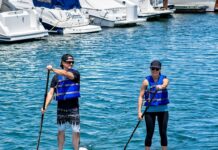Curiosity piqued? Get ready to embark on a journey to discover whether wearing a leash is essential for SUP fitness paddling. Whether you’re a seasoned paddleboarder or just dipping your toes into this exhilarating sport, we’ve got the answers you’re searching for. With safety and convenience in mind, we’ll delve into the pros and cons of wearing a leash, ensuring you’re well-equipped to make an informed decision. Ready to paddle into the world of SUP fitness? Let’s dive in!
Review contents
Safety Considerations
Understanding the Importance of Leash
When it comes to stand-up paddle (SUP) fitness paddling, there are important safety considerations to keep in mind. One of the most crucial aspects is understanding the importance of wearing a leash. A leash is a vital piece of equipment that connects the paddler to the paddleboard, ensuring that they remain tethered and connected to their board at all times. It acts as a lifeline, providing a sense of security and preventing potential accidents.
Potential Dangers of Not Wearing a Leash
Not wearing a leash while SUP fitness paddling can lead to various potential dangers. Without a leash, there is a risk of board separation, especially in challenging conditions such as strong currents or windy weather. This can result in the paddler losing control and potentially becoming stranded or unable to reach their board. Additionally, without a leash, it becomes challenging to retrieve the board if you fall off or lose balance. This can be particularly dangerous in open water or areas with other watercraft where the board might drift away, making it difficult to get back to shore or safety.
Risks and Hazards of Wearing a Leash
While wearing a leash is generally beneficial for safety, it is essential to be aware of the risks and hazards associated with using one. An entanglement or snagging risk exists if the leash gets caught on underwater obstacles, vegetation, or other objects. This can create a potentially dangerous situation, especially if the paddler becomes tangled and is unable to free themselves quickly. Additionally, a leash can restrict mobility and movement, impacting your ability to perform certain SUP fitness movements or navigate effectively. Moreover, leash-induced injuries can occur if the paddleboard recoils or rebounds forcefully after being pulled by the leash, leading to collisions or falls.
SUP Fitness Paddling
Exploring the World of SUP Fitness Paddling
SUP fitness paddling combines the benefits of stand-up paddleboarding with a focus on fitness and exercise. It involves performing various movements, exercises, and workouts on a paddleboard, often in calm or flatwater environments. SUP fitness paddling provides an excellent opportunity to engage in low-impact workouts while enjoying the peaceful serenity of the water. From yoga poses to strength training routines, the possibilities for fitness activities on a paddleboard are vast.
Benefits of SUP Fitness Paddling
Engaging in SUP fitness paddling offers numerous benefits for both physical and mental well-being. Firstly, it provides a full-body workout that targets multiple muscle groups, including the core, arms, and legs. The constant balancing and stabilizing required on a paddleboard enhance muscle strength and endurance. Additionally, the low-impact nature of SUP fitness paddling reduces stress on the joints and minimizes the risk of injuries compared to high-impact exercises. Moreover, being surrounded by nature and the calming effects of water contribute to improved mental health, reducing stress and promoting relaxation.
Safety Measures for SUP Fitness Paddling
Maintaining safety while participating in SUP fitness paddling is crucial. In addition to wearing a leash, there are other safety measures to consider. It is essential always to wear a personal flotation device (PFD) or life jacket, especially in areas where it is required by law. Additionally, understanding the weather conditions and monitoring forecasted changes can help avoid potentially hazardous situations. It is also recommended to inform someone of your paddling plans, paddle with a buddy whenever possible, and ensure that you have appropriate hydration and sun protection gear. Regularly practicing and improving your swimming abilities can also enhance your safety while participating in SUP fitness paddling activities.
Pros of Wearing a Leash
Enhanced Personal Safety
Wearing a leash significantly enhances personal safety during SUP fitness paddling. It ensures that the paddler remains connected to the board at all times, preventing accidental separation and potential dangers associated with losing the board. In case of a fall or loss of balance, the leash enables quick retrieval and minimizes the risk of becoming stranded or unable to reach the board. By maintaining a strong connection, the leash provides a sense of security and peace of mind, allowing the paddler to focus on their fitness activities without worrying about losing control.
Preventing Board Separation
One of the main advantages of wearing a leash is the prevention of board separation. A leash acts as a lifeline, keeping the board within reach even in challenging conditions with strong currents or windy weather. This is particularly important in open water or areas with other watercraft, where the board can easily drift away if not securely attached to the paddler. By avoiding board separation, the leash helps maintain control and prevents potential accidents or injury.
Easier Retrieval of Equipment
In the event of a fall or loss of balance, having a leash attached to the paddleboard allows for easier retrieval of equipment. Instead of struggling to swim or chase after a drifting board, the paddler can simply pull on the leash to bring the board back within reach. This not only saves time and energy but also reduces the risk of exhaustion or getting further away from safety. With a leash, equipment retrieval becomes a seamless process, ensuring a smooth continuation of the SUP fitness paddling session.
Maintaining Control in Challenging Conditions
Wearing a leash provides an added advantage of maintaining control in challenging conditions. In rough waters or strong currents, it is crucial to have a secure connection to the paddleboard to navigate effectively and stay balanced. A leash helps to anchor the paddler to the board, allowing them to maintain stability and control even in turbulent environments. By preventing board separation and offering additional support, the leash enables the paddler to overcome challenging conditions and continue with their SUP fitness paddling activities comfortably.
Cons of Wearing a Leash
Entanglement and Snagging Risks
While there are numerous advantages to wearing a leash, it is important to acknowledge the potential risks associated with entanglement and snagging. In certain environments, such as areas with underwater obstacles or vegetation, there is a chance that the leash could get caught, leading to a potentially dangerous situation. The paddler may become entangled and find it challenging to free themselves quickly, increasing the risk of injury or drowning. Therefore, it is crucial to carefully consider the specific conditions and hazards of the paddling area before deciding whether to wear a leash or opt for alternative safety measures.
Restrictions on Mobility and Movement
Another consideration when wearing a leash is the potential restriction on mobility and movement. Depending on the leash length and attachment point, it can limit the paddler’s ability to perform certain SUP fitness movements effectively. More dynamic exercises or yoga poses may be hindered by the leash, reducing the range of motion or causing discomfort. This can impact the overall experience and effectiveness of the SUP fitness paddling session. Therefore, individuals must weigh the importance of unrestricted movement against the safety benefits provided by wearing a leash.
Potential for Leash-Induced Injuries
Although rare, leash-induced injuries are a potential risk to be aware of when wearing a leash during SUP fitness paddling. If the paddleboard recoils or rebounds forcefully after being pulled by the leash, the paddler may experience collisions or falls, leading to various injuries. To minimize the chances of leash-induced injuries, it is crucial to ensure that the leash is properly attached and positioned. Additionally, practicing good body positioning and maintaining a safe distance from the board can help prevent accidents or collisions caused by leash tension.
Leash Types and Considerations
Coiled Leashes vs. Straight Leashes
When choosing a leash, two primary options to consider are coiled leashes and straight leashes. Coiled leashes are preferred by many paddlers for SUP fitness paddling due to their compact and tangle-resistant nature. They tend to stay out of the way and offer increased freedom of movement. However, it is important to note that coiled leashes can exert more tension when stretched, potentially increasing the risk of leash-induced injuries. On the other hand, straight leashes are commonly used and offer a simpler design. They do not have the same level of retraction as coiled leashes, but they provide a consistent tension and can be more suitable for beginners or paddlers who prioritize safety over increased mobility.
Attachment Points and Positions
The attachment point and position of the leash are crucial considerations when wearing one during SUP fitness paddling. Typically, the leash is attached to the ankle or calf of the paddler, allowing for unrestricted movement and reducing the risk of entanglement. Some paddlers may prefer attaching the leash to their waist belt or life jacket for added convenience and accessibility. Experimenting with different attachment points can help find the most comfortable and suitable position for individual preferences and safety requirements.
Choosing the Appropriate Leash Length
Selecting the appropriate leash length is essential to maintain a balance between safety and unrestricted movement. A leash that is too short can restrict mobility and make certain movements challenging, while a leash that is too long can create unnecessary drag or increase the risk of tangling. As a general guideline, a leash length that allows the paddleboard to stay within arms’ reach is recommended. However, personal preference, paddling style, and specific SUP fitness activities should also be taken into account when determining the appropriate leash length for individual needs.
Quality and Durability of Leash Materials
The quality and durability of the leash materials play a significant role in ensuring a safe and reliable experience while SUP fitness paddling. Inferior quality materials can lead to leash breakage or sudden failure, compromising the paddler’s safety. It is important to choose a leash made from high-quality materials that are designed to withstand the rigors of SUP fitness paddling. Reinforced stitching, durable swivels, and strong Velcro straps are desirable features to look for when selecting a leash. Investing in a reputable brand and regularly inspecting the leash for any signs of wear or damage can help prevent accidents and ensure a longer lifespan for the equipment.
Specific SUP Fitness Paddling Factors
Impact of SUP Fitness Movements
SUP fitness movements, exercises, and workouts can have different impacts on wearing a leash. Certain activities that involve rapid and dynamic movements, such as HIIT (high-intensity interval training) or paddleboard yoga flows, may benefit from a leash that allows for increased mobility and freedom of movement. On the other hand, activities that require a stable base or more static positions, such as strength training or static yoga poses, may be less affected by leash restrictions. It is important to consider the specific SUP fitness movements involved in a session to determine the impact of wearing a leash on overall performance and safety.
Engaging in High-Intensity Workouts
For those engaging in high-intensity workouts during SUP fitness paddling, the pros and cons of wearing a leash become even more critical to evaluate. High-intensity workouts often involve quick transitions, explosive movements, and increased exertion. In these scenarios, the leash’s impact on mobility and movement may be more noticeable and potentially limiting. However, the benefits of wearing a leash, such as enhanced personal safety and prevention of board separation, should not be disregarded, especially in challenging conditions or areas with strong currents. Striking a balance between safety and performance is essential for a successful high-intensity SUP fitness paddling session.
Effectiveness of Leashes during SUP Fitness Paddling
The effectiveness of leashes during SUP fitness paddling relies on several factors, including the type of activities, water conditions, and personal preferences. For SUP fitness movements that involve a more stationary or slow-paced approach, the leash’s impact on mobility may be less of a concern, making it easier to focus on safety benefits. However, in fast-paced or advanced SUP fitness workouts that require quick transitions or extensive movement, the leash’s restrictions on mobility may become more noticeable. In this case, individuals may need to adapt their movements or consider alternative safety measures to maintain their performance without compromising safety.
Expert Opinions and Recommendations
Insights from SUP Fitness Instructors
When seeking expert opinions and recommendations on wearing a leash during SUP fitness paddling, SUP fitness instructors offer valuable insights. These professionals have a wealth of experience and knowledge about the benefits, risks, and considerations associated with wearing a leash. They can provide guidance on choosing the right leash type, length, and attachment point based on individual preferences and the specific SUP fitness activities. SUP fitness instructors often prioritize safety and personal assessment when it comes to leash usage, ensuring that their students feel confident, secure, and able to perform to the best of their abilities while on the water.
Views of Professional Paddlers
Professional paddlers, who have achieved a high level of skill and expertise in the sport, also have valuable views on wearing a leash during SUP fitness paddling. Their experiences vary based on the specific disciplines they focus on, such as racing, surfing, or SUP fitness. While some professional paddlers may prioritize mobility and not wear a leash during certain activities, others opt for a leash as an added safety measure, regardless of their expertise. Their perspectives can provide valuable insights into the considerations and trade-offs between performance and safety when deciding whether to wear a leash during SUP fitness paddling.
Safety Guidelines from Water Sports Organizations
Water sports organizations, such as the American Canoe Association (ACA) and the International Surfing Association (ISA), often provide safety guidelines and recommendations for various paddle sports, including SUP fitness paddling. These guidelines are based on extensive research, expert opinions, and best practices to ensure the well-being of paddlers. While the specific recommendations may vary across organizations, they typically advocate for the use of leashes as an essential piece of safety equipment during SUP fitness paddling. Following these guidelines, which often emphasize personal risk assessment and individual comfort levels, can contribute to a safer and more enjoyable paddleboarding experience.
Considerations for Different Water Environments
Flatwater SUP Fitness Paddling
When engaging in SUP fitness paddling in flatwater environments, the considerations for wearing a leash differ from other water conditions. In calm and controlled settings, the risk of board separation may be lower, and mobility limitations can be outweighed by safety benefits. Wearing a leash can provide reassurance and prevent potential accidents, especially when performing static or low-movement SUP fitness activities. However, individuals must still assess the specific conditions and potential hazards of the flatwater environment to make an informed decision regarding leash usage.
Open Water Conditions
In open water conditions, such as lakes or oceans, the risks associated with not wearing a leash significantly increase. Strong currents, changing tides, and wind patterns can create unpredictable situations where board separation becomes a serious concern. Wearing a leash in open water provides a vital safety measure, ensuring that the paddler remains tethered to the board even in challenging conditions. The leash aids in quick board retrieval, preventing potential accidents, and allowing the paddler to focus on their SUP fitness goals without worrying about losing control.
River or Whitewater SUP Fitness Paddling
When participating in SUP fitness paddling in rivers or whitewater environments, additional considerations come into play regarding leash usage. The unpredictable nature of river currents and potential obstacles make entanglement risks more significant. In these scenarios, individuals may need to assess the specific hazards in the river or whitewater environment and determine whether wearing a leash is the safest option. Alternatives, such as using a quick-release belt system or practicing self-rescue techniques, may be more appropriate in situations where entanglement risks outweigh the benefits of a leash.
Choosing a Leash for Specific Environments
Choosing the right leash for specific water environments is essential to ensure optimal safety and performance. For flatwater SUP fitness paddling, coiled leashes are often preferred due to their tangle-resistant properties and increased freedom of movement. In open water conditions, both coiled and straight leashes can be suitable options, depending on personal preferences and desired levels of mobility. For river or whitewater SUP fitness paddling, alternative safety measures may be more appropriate, considering the entanglement risks associated with leashes. Evaluating the specific hazards, water conditions, and individual comfort levels can help determine the most suitable leash option for each environment.
Personal Preference and Risk Assessment
Understanding Individual Comfort Levels
Personal preference plays a significant role in deciding whether to wear a leash during SUP fitness paddling. Some individuals may feel more comfortable and secure with a leash, while others may prioritize unrestricted movement and choose alternative safety measures. Assessing personal comfort levels and the impact of leash restrictions on performance is crucial for making an informed decision. Trial and error, along with self-awareness, can help individuals determine the best approach that balances their safety requirements and SUP fitness goals during paddling sessions.
Factors to Evaluate for Personal Safety
When prioritizing personal safety during SUP fitness paddling, there are multiple factors to evaluate. These include an individual’s swimming abilities, experience with paddleboarding, familiarity with the specific water environment, and knowledge of potential hazards. Strong swimming skills are particularly important, as they provide an added layer of safety and confidence when participating in SUP fitness activities. Conducting a personal risk assessment based on these factors can significantly contribute to a safer and more enjoyable paddleboarding experience.
Importance of Customized Decision-Making
Ultimately, the decision of whether to wear a leash during SUP fitness paddling should be based on individual preferences, risk assessment, and understanding the specific requirements and conditions of each paddling session. Customized decision-making ensures that personal safety, performance goals, and comfort levels are taken into account. It is essential to acknowledge that what may work for one paddler may not be the best choice for another, highlighting the importance of personalized assessments and informed choices.
Conclusion
Should you wear a leash while SUP fitness paddling? The answer depends on a variety of factors, including personal preferences, water conditions, and specific SUP fitness activities. Understanding the importance of a leash for personal safety cannot be overstated, as it prevents board separation, aids in equipment retrieval, and enhances control in challenging conditions. However, it is crucial to consider the potential risks associated with entanglement, leash-induced injuries, and mobility restrictions.
By weighing the pros and cons, considering expert opinions, and evaluating individual comfort levels, paddlers can make an informed decision regarding leash usage. Customized decision-making based on personal risk assessment ensures that safety, performance, and enjoyment are prioritized during SUP fitness paddling sessions. Whether opting for a leash or choosing alternative safety measures, the key is to make a choice that aligns with individual needs and contributes to a safe and rewarding paddleboarding experience.



































